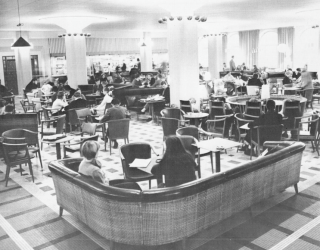The ground floor in this “ynlingaborg,” which the building was sometimes referred to as, was occupied by konviktorium, Atheneum and staff housing. One came to Athén through the southern façade’s entrance facing Tegnérsplatsen while the entrance to konviktoriet was placed in the middle of the western façade. The upper level contained Athéns journalroom, containing periodicals as well as new literature, as well as the large banquet hall, which occupied the entire west wing’s second floor.
1868 the first addition to the building was constructed along Sankt Annegatan. It had two floors and was decorated with a sångsal on the second floor. The façade’s design was made to match the older building. Here too the ground floor was made smooth while the second floor is equipped with lisener and bågfris. However, the new wing was built entirely in red brick.
Already in 1880 the planning for an additional expansion to the association building began. Helgo Zettervall drew up a suggestion and the courtyard north of the existing complex was purchased. Zettervall’s idea was that the Academic Associations western façade should be included in the University Place’s plan and stand as a counterpart to the university building. He construction he drew up toward the north, along Sandgatan, was a mirror-reflection of Strömbärg’s façade from 1851. The north-western tower, together with a new new, identical tower, became a centrepiece and the south-western tower and the anticipated north-western tower became sidorisaliter. However, this suggestion was never followed through and it was not until 1903 before the planning of an addition to the building-complex was taken seriously. The three architects Theodor Wåhlin, Fredrik Sundbärg and Folke Zettervall (the son of Helgo Zettervall) then drew a suggestion each. It was Fredrik Sundbärg’s proposal, in a slightly revised form, that became the winner.
Tillbyggnader från år 1868 och 1947 längs Sankt Annegatan.
Stora salen år 1897. Kulturens arkiv.
1909 the construction commenced. The expansion was constructed in red maskintegel on two floors with a staircase gabled avant-corps with bay windows facing north and a circular tower standing six floors tall in the façade’s southern part. The tower was used to create a smooth transition between the two buildings. Between the old building’s north-western tower and the newly built tower was a common entrance with an indented portalparti with round arches on the first and second floor and a trappgavel överst. The second floor’s round arch was a few years later adorned by a bronze relief made by Axel Ebbe, which represents “A stag with spirit hot as storms through the country road’s dust catching the goal he does not know.” The façade between the avant-corps in the north and the tower in the south received a very varied execution. The windows on the ground floor were made to match the older building, large and round-headed. The second floor was pulled in and gave way to a terrace with brick, latticed balustrade. Here, the windows were narrow and linked in larger arcs. The upper floor has a series of smaller, closely-spaced windows. The façade was, as the round tower, finished with battlements.
Within the new entrance, a vestibule was created with columns made out of brick and kapitäl of red sandstone. In the old house, Athén had been made significantly larger than before, and the new building was furnished with a dining room and cafe facilities. Above these, a new banquet hall. The top floors were furnished as dorm-rooms.
1946 an extension of Fredrik Sundbärg’s wing was made. The restaurant needed refurbished premises so they chose to build in the terrace that had existed between the northern avant-corps and the round tower at the main entrance. The drawings of the design were made by architecture Hans Westman and the building was constructed in two floors. On the ground floor, the facade is covered with white marble and the upper floor is with red bricks. The windows are straight and white, and the roof is covered with green plate. In the added building a dining room was furnished. The old, exterior walls were retained inside the restaurant venue and one of the windows became the door connecting the old and new restaurant. In connection with this extension, a new entrance to the restaurant in the round tower opened. The tower room that in 1911 had been decorated as a cafe turned into a cloakroom.
Foto från år 1982
Tillbyggnaden från år 1911. Kulturens arkiv.
In 1947 another addition to the building was carried out, according to Hans Westman’s drawings. It was the first student housing of the kind that later came to be built in several parts of the city. North of the previously described sångsalsbyggnaden by Sankt Annegatan in the Aspergrenska tomten an “experimenthouse” was built with 17 identical dorm rooms with a toilet and shower in each corridor. The facades are clad with red stavtegel, divided into areas of bands in white marble. The door has rounded corners and above it sits an owl in sandstone, which originally had sat on Sundbärg’s facade facing Sandgatan.
The last major reconstruction that the house at Sandgatan has undergone was completed in 1951. The east wing in Strömberg’s original “castle” had only one floor. As early as in 1939, work had begun with a plan to build in the inner courtyard and add to the east wing. Due to lack of funds, this change did not occur until 1951. The interior of the house was also redone and was significantly modernized. All the small rooms that had previously serves as Athén were merged into a single room with windows facing Sandgatan, Tegnérsplatsen and Sankt Annegatan. The Great Hall had indeed received new furnishing and changed its appearance several times before, but the change that now was accomplished was at last almost complete. The pillars were removed and the stands were instead constructed out of steel and concrete beams. Ceilings, walls, floors and fittings were redone, as they also were in Athén and in the stairways and corridors.
Stora salen efter ombyggnaden 1953. AF:s arkiv.
Athen år 1968. Foto Lennart Gullberg. SDS bildarkiv.
The dorm rooms on the top two floors were during the 1960s gradually utilized for various administrative needs due to the increased number of students. During the 1970s, when the number of students fell, some of the rooms on the third and fourth floor were instead rented out . The year 1973 Athén closed and the venues were taken over by Akademibokhandeln.
During the 1970s, a big part of the student-life moved to the Nations’ houses and the newly built Sparta. However, soon an opinion was once again brought back regarding another investment in the old casle in the middle of Lund. In 1980, the Great Hall was renovated. Athén was at the time a bookstore under AF’s control called Akademibokhandel. The old café Tua was a kiosk.
Since many activities and operations returned to the building during the 1980s, it was clear that a new makeover was needed to save the castle from decay, but it wasn’t until 1994, with the help from large donations from the business sector, that the renovations could begin. Among other things, Lilla Salen’s paintings were restored and work with the ventilation system was carried out. At the same time, renovations were also performed in what today is known as Tegnérs Matsalar. The ceiling that exists today i Stora Salen is also from this renovation. Athén was turned into two lecture halls called Samarkand and Aten. These were managed by the University.
In the early 2000’s, a decision was made that Athénshould become an open cafe-venue and the rebuilding began. In the autumn of 2004, the new premises were inaugurated. The interior of the re-opened Athén is fully renovated but it is stylistically inspired by the 1950s and 1960s aesthetics.
The information is taken from the municipality of Lund’s preservation program which you can find here:







